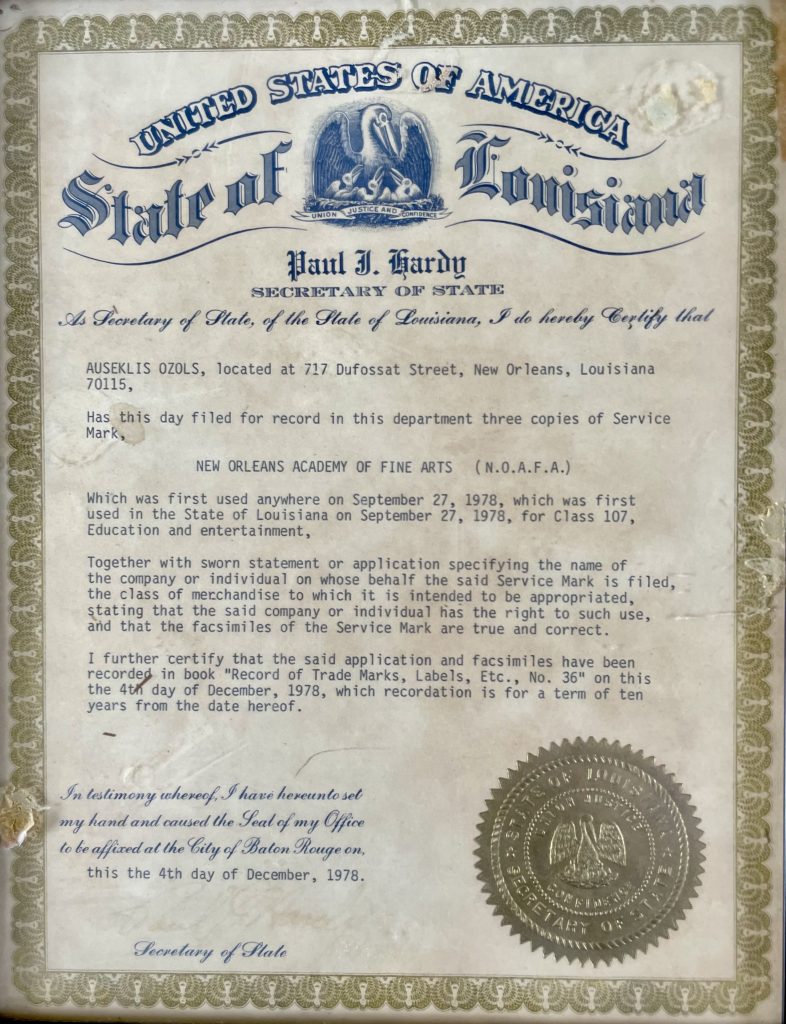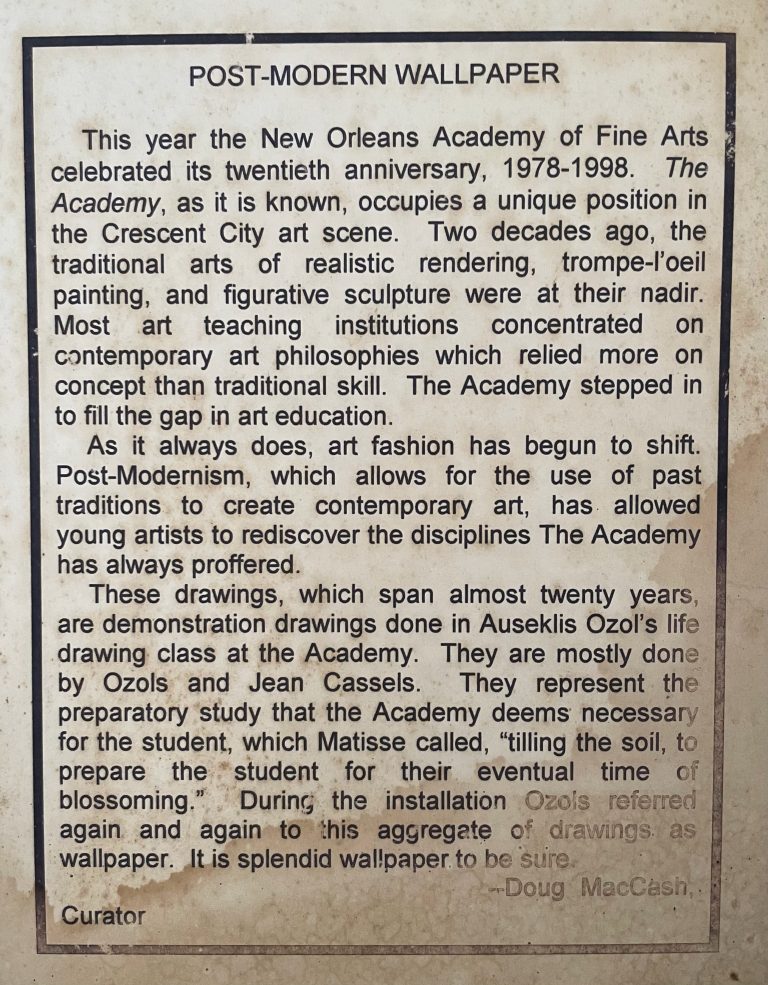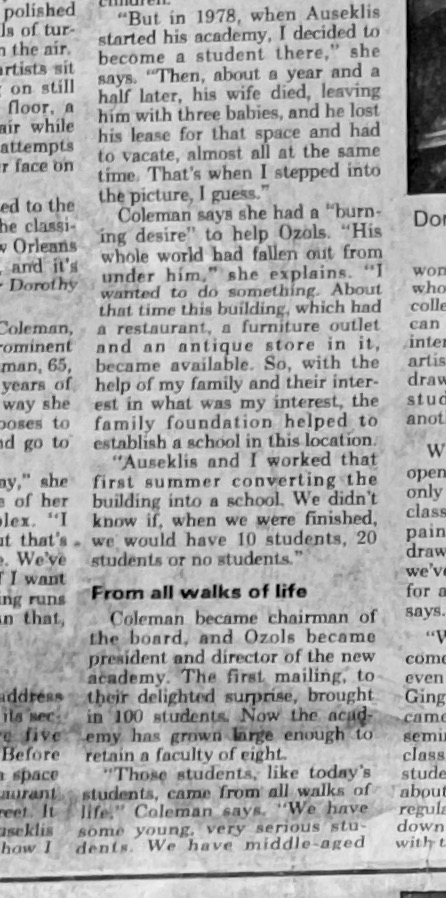
“The Collection was born as a result of my untoward expulsion from the school, the New Orleans Academy of Fine Arts, that I founded in 1978, and which I still retain the name to.
( *edit: Auseklis Ozols sold the Name, the New Orleans Academy of Fine Arts to the Coleman family in March 2024, four years after his retirement in 2020. He was retaining the name for his children and had refused to sell after being asked in previous decades. “The only thing I have to leave my children when I die is the name, The New Orleans Academy of Fine Arts.” The Coleman family has been using the name, NOAFA Limited, through 2024 because Ozols planned to keep the original name for his family.)
It was my life’s work, 42 years maintaining aesthetic disciplines which had been abandoned by other local art schools. I was rejected as Director Emeritus by the owner of the building that housed the Academy.” (Auseklis Ozols, 2020 )
The below is written by Auseklis Ozols in 2022:
The following is an encapsulation of the birth of NOAFA, [New Orleans Academy of Fine Arts]
I arrived in New Orleans in 1970, to accept a position as Preparator, for the new Wisner Education wing of the recently renamed Issac Delgado Museum of art, to “ The New Orleans Museum of Art.” Having come from Philadelphia, well imbued with it’s cultural history and educated by its best schools, the University of PA, The Tyler School of Art at Temple U, and the first and oldest art Academy in America, the Pennsylvania Academy of Fine Arts. I received several awards from PAFA, including the coveted, Cresson traveling scholarship for study in Europe. I met my future wife here, and I was married in 1972 to Gwendolyn Laan, the daughter of Cyril Laan, a local merchant who arrived in New Orleans with his family from Holland in 1948.
The 1960s were formative years in University art schools around the country, Abstract Expressionism was at its zenith and many professors and instructors were traditional liberals, and many left leaning or outright Marxists. The new avant-garde art writers of New York, London and Paris became the arbiters of the new visual aesthetics, or the new tastemakers. The most prominent were, Harold Rosenberg and Clement Greenberg. Most university art departments jumped on the new bandwagon. Classic art education was neglected, even abandoned in favor of the new unrestricted, unhindered freedom of self expression.
In my first few years in NOLA I became familiar with the three main art schools and their curricula. Newcomb art school at Tulane, the UNO art department and LSU. All fine schools, with fecund histories, but fallen under the pall of the “NEW” and exiting directions. Foundation courses such as Artistic anatomy, Life drawing and Painting, Portrait, landscape, still life, color theory, materials and techniques and many others, which were the mainstay courses for centuries were being abandoned, as being too restrictive to the free spirit.
With the advent of “Conceptual Art ” I watched the local student shows degrade to the point where I saw a great need, with the possibility where I might risk the establishment of a small Academy to reinstate the much needed lost disciplines.
Beethoven built on Mozart, Chopin built on Beethoven, Velasquez built on Caravaggio, Eakins on Velazquez and Louis Prima’s rhythms on Sicilian folk songs.
As history has taught us, nothing can be built on a vacuum, so most disciplines look to the past for substance and guidance. Before the 1960s, it was generally understood that there was a distinction between the “Fine Arts,” and the Utilitarian Arts, The Fine Arts were considered to be, painting, sculpture, engraving, etching, and other forms of intaglio. The “ Utilitarian Arts,” such as ceramics, illustration, commercial art, the fiber arts, calligraphy, photography, etc. As it stands today, there is no distinction between any of the arts or crafts, there is no longer a STANDARD of JUDGEMENT that arbitrates aesthetic values.
During my first few years in NOLA I was fortunate enough to have formed friendships with prominent members of the artistic community. My employment experience, along with the New Orleans Museum of Art, included working with Koch and Wilson, the city’s preeminent architectural firm and working with William Groves, prominent collector of Louisiana 18th, 19th, and 20th century artists. I was asked to assist with preparatory work at the Historic New Orleans Collection. I befriended like-minded artists and acquaintances with whom I held meetings, in search of a market research format, which we did, and implemented ideas that were successful. Eventually we had a positive response from our mailings, encouraging enough to plan the birth of NOAFA.
I had the opportunity to test a prospective Still-life class, which I held at the St. Charles Avenue Presbyterian church. It was well received, and gave me the courage to proceed.
With the help of a local attorney, Ben C. Toledano, I secured a fine location for the school. A large 3d story loft on Magazine st. with a NNW exposure. It had just been vacated by the Lief Anderson Dance Studios, Leif being the daughter of the south’s most famous painter, Walter Anderson {1903-1965} also a graduate of PAFA.
Our first instructors were to be, M. Dell Weller, my sister-in-law Magtillt Laan, also a graduate of the PAFA, and myself. Class schedules were printed and mailed with enough response to forge ahead. Financial assistance was given by Ben Toledano, Mrs. Arthur Fort and my mother in law, Mrs. Cyril Laan.
I promptly set about preparing Art Studio implements. I designed and built 15 unique wooden studio easels, 15 drawing benches of my design, and model stands and other furnishings necessary for a properly equipped painting and drawing studio. I received my certificate of business from the La. secretary of state in 1978 and classes began. I was Director and senior instructor, and my wife Gwendolyn, chief secretary. The response was most encouraging, as classes filled.
All went well until, in 1980, great tragedy struck me and my three young daughters, my dear wife Gwendolyn was killed by a neighbor’s gunshot. My world collapsed. At the same time the building that my school occupied was sold, and the new owners did not want to continue my lease.
One of the students in my still life class was Mrs. Dorothy Coleman, who approached me and said, “Auseklis, I don’t want you to give up the school, we { my family } have properties around the city, lets go see if any of them would be suitable for this school.” She was like a God sent miracle at that time. A location was found further up at 5256 Magazine St. in an 1880s two-storied structure, with an even more northerly exposure. I invited Mr. and Mrs. Coleman to lunch at Manale’s and presented to them my proposition of forming a partnership as a non-profit, including galleries for exhibitions of student and other work. They were both extremely positive to that, and we shook hands, and as far as I was concerned it was all properly settled. Being a neophyte in legal matters, and thoroughly preoccupied with the care of my motherless children, I felt all was fine with that arrangement. At that time, the building at 5256 housed three well established businesses. Miraculously, their leases were broken and soon the building was empty.
Mrs. Coleman was an accomplished artist, having studied art at Newcomb College at Tulane in the 1940s, before Newcomb fell under the pall of New York tastemakers. She wholeheartedly supported my aesthetic philosophy, and provided the means for its continuance.
Having had architectural training in college, I welcomed the task of redesigning the building to house a viable Fine Arts Academy. I drew the plans for an addition to house a lecture room and an advanced painting studio. I designed the non existent attic space under the roof, with large north lights, as the primary life painting studio. The two front porches were closed in for office space. The two large downstairs rooms became the galleries. The design of the galleries was unique in the city, floor to ceiling 3/4 inch ply, covered in raw Belgian linen. Permitting vastly simplified gallery installation. I introduced New Orleans to the German “Floreat “ nail that left no mark in the linen, and searching for studs, spackling and repainting after every show, was no longer necessary.
I planned, designed and built {with my hands} canvas racks and storage spaces, clean up areas and shelves for still life materials. I built 3 model stands, for portrait and life painting. I built custom tables for beginning drawing and advanced still life. A small school store for art materials was included. Mr. Coleman sent me talented Vietnamese carpenters as assistants.
By 1982 I had hired several more well known local artists, along with Kinzey Branham, a fine sculptor. With his assistance we prepared the sculpture department in an adjacent structure owned by the Colemans. Brochures and class listings were printed and mailed. there was a wonderful response and classes were filling up. The Academy Gallery became a prime and sought after location for local exhibitions. The waiting list increased rapidly as monthly exhibitions were held and opening nights became popular venues for the local art crowd.” (Auseklis Ozols)


This succinct history of Mr. Ozols’ preeminent part in the creation of The New Orleans Academy of Fine Arts is a much needed chapter of the long story of the arts in New Orleans.
His appraisal of the state of the arts from the 1960’s to today exposed the dearth of excellence in teaching the truly meaningful appreciation of traditional methods and theory. He rowed against the prevailing current and left a lasting imprint on the city’s artistic life.
Lyn Hill Taylor
Abbey Art Works
St. Joseph Abbey
Covington, La